| 1 | King cobra |
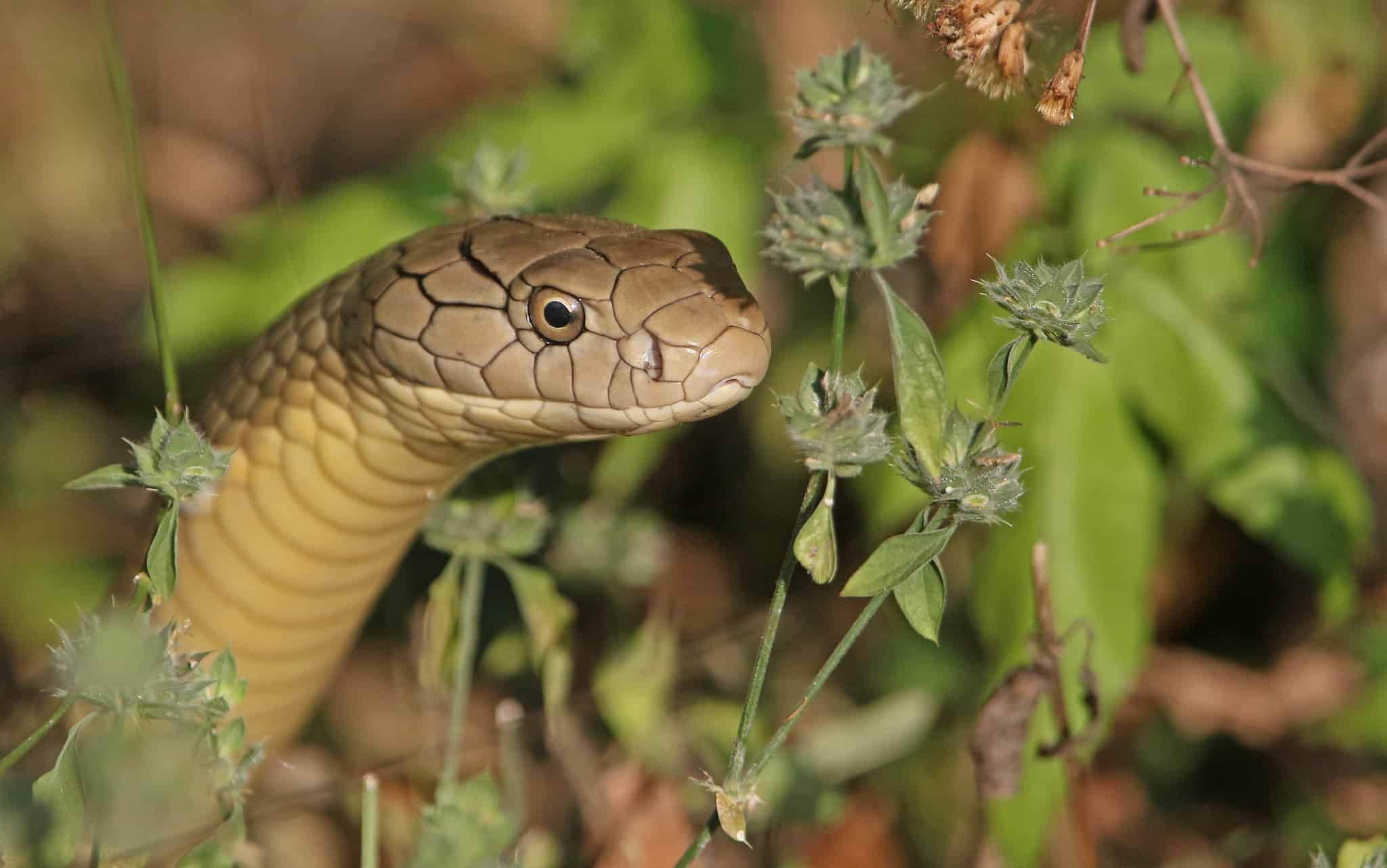
Location: Indian subcontinent, southeast Asia.
The king cobra receives its kingly moniker for two reasons. Firstly, they’re the longest venomous snake in the world, at a confirmed wild record of 5.85 metres. Secondly, 95% of their diet consists of other snakes, with only the occasional clouded monitor to spice things up.
King cobras rank at the top of the food chain, and no other snake can deny it. Their list of confirmed meals is endless, whether it’s sunbeam snakes, monocled cobras, Indian wolf snakes, oriental ratsnakes, or small Indian pythons. In 1957, a 3.66 metre king cobra was reported trying to eat a 2.79 metre reticulated python. This may have been the single largest snake-on-snake prey ever recorded.
The king cobra can go months without a meal, thanks to a slow metabolism. But this doesn’t mean that they won’t stuff their face if given the opportunity, as one king cobra was observed eating 82 snakes over a single winter. King cobras are such a snake vacuum cleaner that without them, the populations would probably get dangerously out of control.
King cobras have an enormous range, meaning that their favourites inevitably vary by region. For example, a study in the western Ghats mountains of India found that the oriental ratsnake was their main prey, followed closely by the Malabar pitviper.
To prevent their slithery prey from escaping, the king cobra has incredibly strong jaws. In fact, they possess the most powerful bite force of any living snake, according to scientific measurements (with the saltwater crocodile ranking on top).
| 2 | Eastern kingsnake |
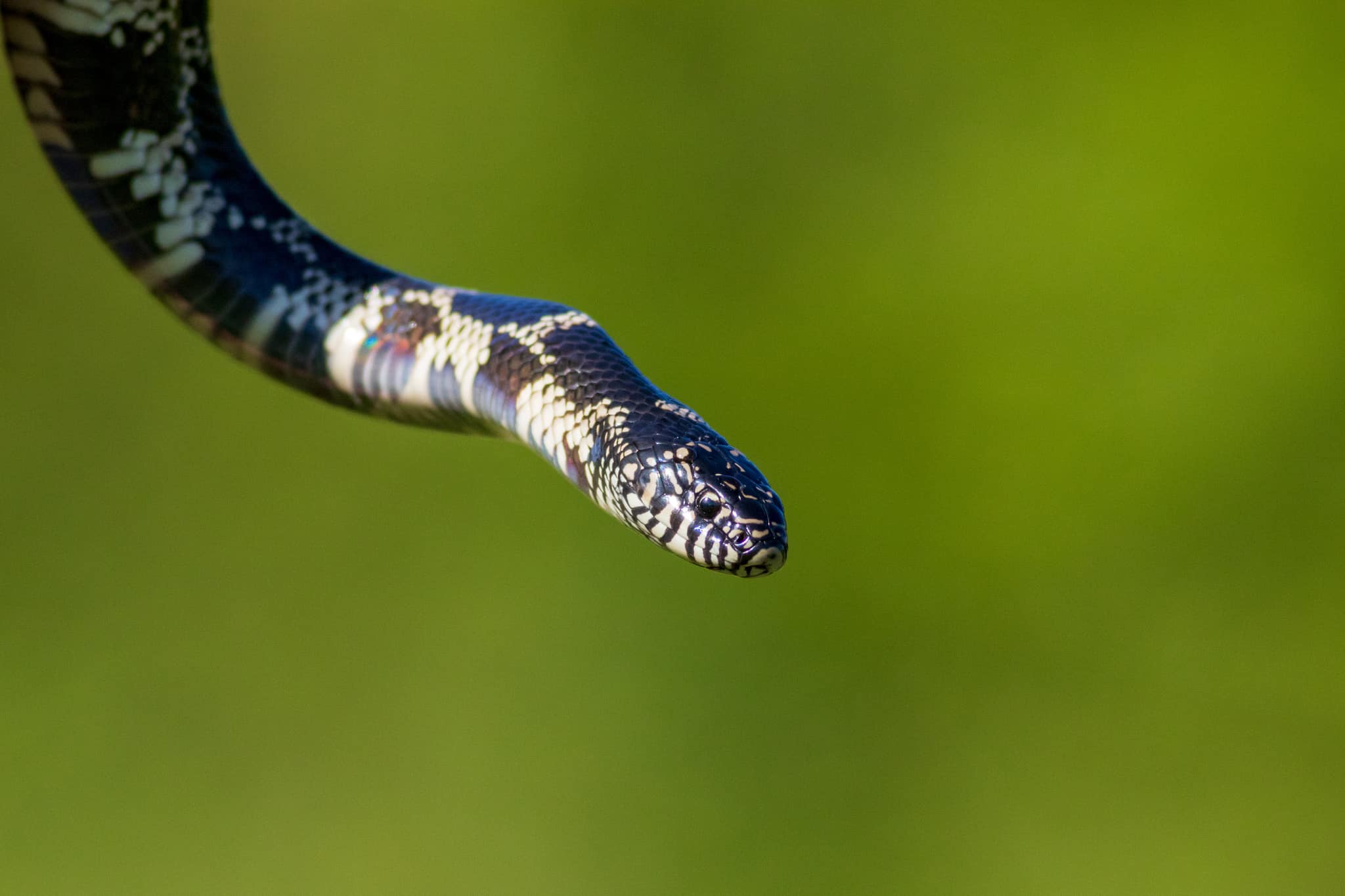
Location: USA.
A super-common species of the eastern USA, which lacks any venom, preferring to constrict its prey to death. The eastern kingsnake (Lampropeltis getula) eats a variety of meals, including the white-footed mouse, five-lined skink, and eggs of the northern bobwhite quail. But fellow snakes make up a larger proportion, including both lethal and harmless species.
Lamprpeltis getula has a happy blessing for a snake – natural resistance to the venom of other snakes. They’re born with this resistance, which is why they can swallow a full, overflowing venom gland and not suffer. This resistance likely involves immune system antibodies, as when mice were injected with kingsnake blood, they too gained resistance to cottonmouth venom.
Eastern kingsnakes can reach 208.3cm, and can therefore fit plenty of snakes inside their bodies. Despite being venom resistant, they take no precautions when hunting; their natural instinct is to bite other snakes by their jaws, clamping down to prevent a defensive strike. Lampropeltis getula has eaten too many snakes to list over the years, but a few include cottonmouths, ringneck snakes, eastern garter snakes, northern watersnakes, and massasaugas.
| 3 | Mussurana (Clelia clelia) |
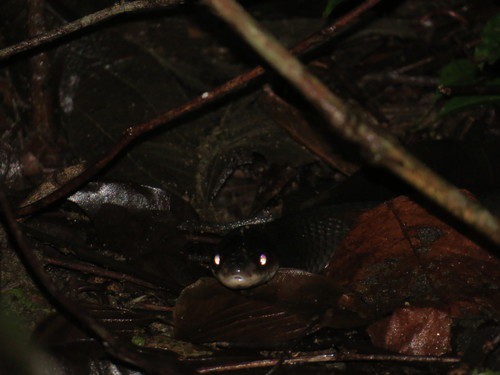
Location: south and central America.
The number one nemesis of venomous snakes in South America. The mussurana, AKA Clelia clelia, has a gigantic range, stretching from southern Mexico in the far north to Paraguay in the far south.
Mussuranas reach 275cm in the longest individuals, and are commonly spotted in grassy fields directly adjacent to forests, usually on overcast days. They eat snakes almost exclusively, with the occasional lizard. Every iconic snake you can think of, Clelia clelia preys on it: the boa constrictor, South American bushmaster, fer-de-lance, hognosed pitviper and black-necked coral snake are all confirmed. They have full resistance to venom, and a bite from a lethal pitviper has no effect on them.
This South American snake often swallows its prey alive, so that they’re still slithering around in its belly. They have no reservations about swallowing prey larger than they are either. In one observation from 2017, a 50cm mussurana swallowed a 65cm spotted cat-eyed snake. The cat-eyed snake became bunched up in the mussurana’s stomach like an accordion, with only the tip of its tail poking out of its mouth. The cat-eyed snake itself had just swallowed a frog, which was still bouncing around inside its stomach.
After swallowing a fellow snake, the mussurana will sometimes perform a death roll like a crocodile to finish it off. This snake favours ambush and constriction over a paralysing venom.
| 4 | Eastern indigo snake |
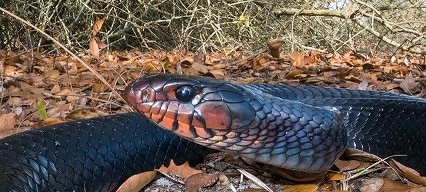
Location: southeast USA.
The eastern indigo snake is one of the USA’s longest, reaching 262.9cm as the confirmed record. These centimeters go towards one purpose – swallowing and digesting other snakes.
The eastern indigo snake has a flexible diet, with one wacky meal including a dead shark. But a massive 2010 study found 47 species on its menu, which included 9 mammals, 4 turtles, 3 birds, and 24 snakes. 185 prey were observed by headcount, and 91 (49%) of those were snakes.
Eastern indigo snakes are most common in Florida, but also appear in Georgia and Alabama. They lack any venom, and rarely constrict their prey. Their strategy is simply to slither after a snake at full throttle charging speeds, grab it, and chew it to death. Eastern indigo snakes are poor at capturing fast-moving small prey, meaning that they skip lizards almost completely, while regularly eating their serpent cousins.
Eastern indigo snakes are known to prey on eastern ribbon snakes, pygmy rattlesnakes, scarlet snakes, and ring-necked snakes. Most impressively, they’re capable of swallowing eastern diamondback rattlesnakes up to 1 metre long, suffering no ill effects from the venom.
| 5 | Malaysian blue coral snake |

Location: Thailand, Vietnam, Malaysia, etc.
The Malaysian blue coral snake (Calliophis bivirgatus) is found all over southeast Asia, mainly in forests, and has several claims to fame. The first is its exceptionally fast-acting venom. A bite from this species can kill a human in just 5 minutes, and this speed comes in great use with its diet, as the Malaysian blue coral snake preys primarily on fellow snakes.
Rather than worrying about safety, Calliophis bivirgatus can paralyse its serpent prey almost instantly, shielding it from vicious comeback bites. This paralysis is accomplished by a unique toxin called calliotoxin, found in no other snake. Rather than hijacking acetylcholine receptors in muscle receptors like a black mamba, this overloads the sodium ion channels of cells, completely freezing their function.
Malaysian blue coral snakes have a particular taste for babies of the king cobra. Weirdly, Calliophis bivirgatus specialises in fast-moving snakes – a strange niche for anyone to get into, but probably a consequence of its rapidly paralysing venom, as they’re the only species with any chance of success.
The Malaysian blue coral snake adheres to the old rule of bright neon colours being highly dangerous. It’s one of Thailand’s more beautiful snakes, with a striking red head and tail, and a body of electric deep sea blue. At a maximum of 185cm, this is one of Thailand’s larger venomous snakes as well.
| 6 | Snake-eater wolf snake |
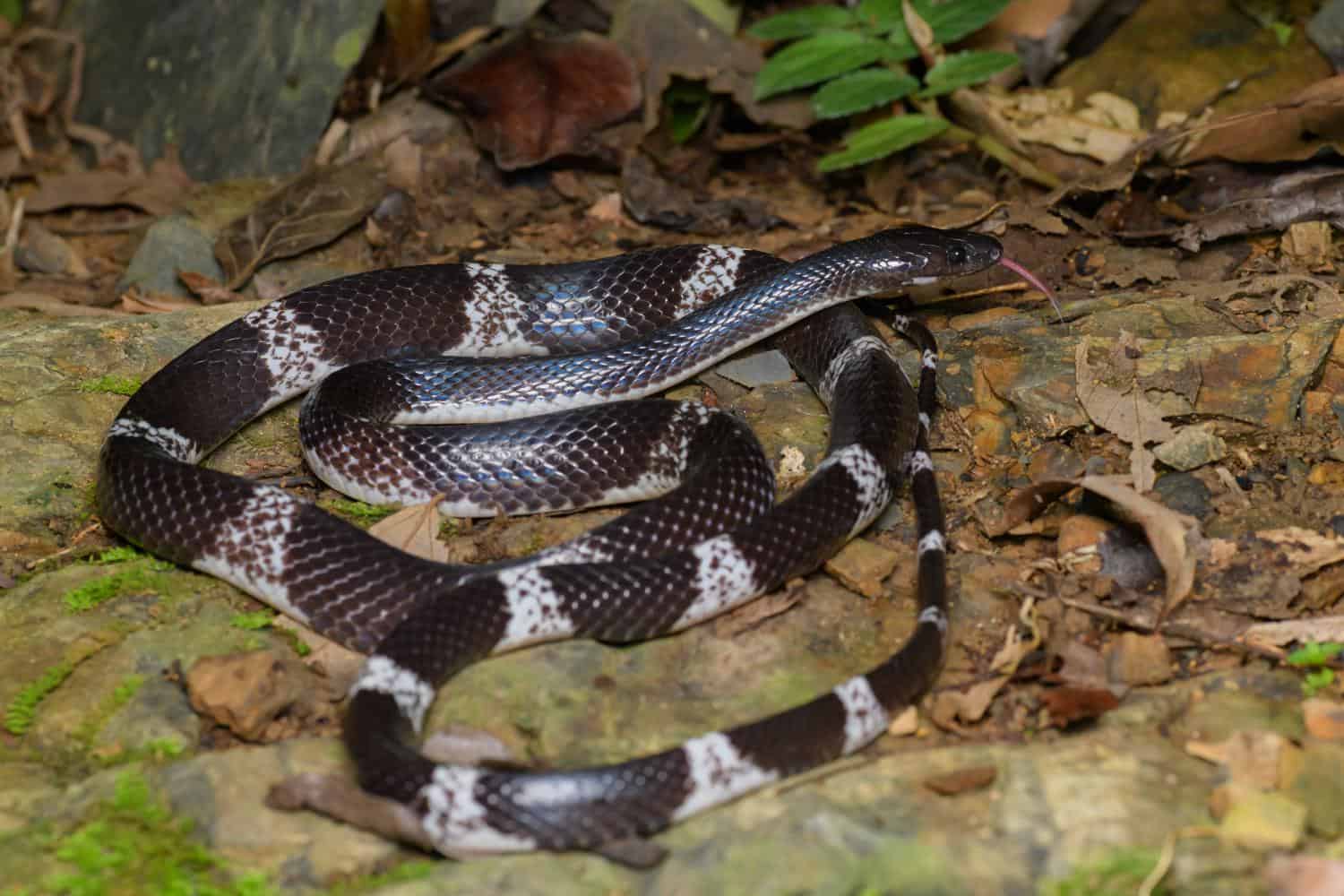
Location: Thailand.
The snake-eater wolf snake (Lycodon ophiophagous) only became an official species in 2009, becoming the 191st Thai snake species. It was separated from its close relative the Ruhstrat’s wolf snake, with one difference being that L. ophiophagous primarily eats snakes. This is a black and white snake with a sleek head and beady black eyes, and a long snout, which typically measures 90cm.
This snake-eating serpent is known only from Thailand. The Lam Ru waterfall in Khao Lak-Lamru National Park is one confirmed habitat. It favours dense forests, particularly along the edges of small streams, and slithers along, thin fragile branches with ease, as well as the ground.
Being such a recent discovery, their exact meals in the wild are unknown, but in captivity, L. ophiophagous happily gobbed up radiated ratsnakes, rainbow mud snakes, red-necked keelbacks and Indo-Chinese ratsnakes. They also ate the golden tree snake; this is another forest snake, so it’s odds on for being one of Lycodon ophiophagous’ wild staples. Golden tree snakes are famous for their power to fly, but based on this information, they might want to watch their landing spot from now on.
| 7 | Mulga snake |
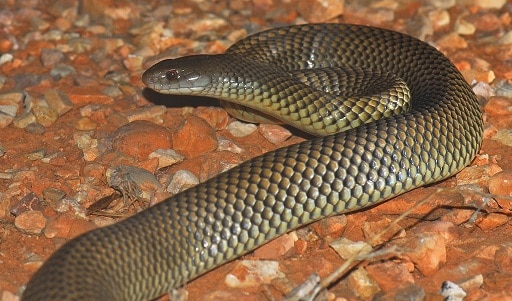
Location: inner Australia.
The mulga, AKA the king brown snake, has a serious taste for fellow serpents, and in the parched Australian outback where they live, there’s plenty to choose from. This is officially Australia’s longest venomous snake, reaching a maximum of 3.3 metres. Mulgas don’t have the worst venom ever drop for drop, but the catch is that they inject a huge quantity, typically 150mg. They’re an apex predator which is only hunted by larger birds of prey.
A 1987 study examined the mulga’s diet, and found a breakdown of 24% mammals, and 51% reptiles, of which many were snakes. Confirmed serpent meals on their list include brown tree snakes, speckled brown snakes, northern brown snakes, crowned snakes, and Gould’s hooded snakes.
Whether mulgas have venom resistance hasn’t been researched much, but they’re definitely resistant to northern brown snake venom, which normally causes gradual paralysis. They’re also immune to their own species’ venom, showing no ill effects when they commit cannibalism.
Mulgas also prey on the infamous eastern brown snake, but this species manages to turn the tables and be moderately resistant to their venom. Nature is fighting back, and evolution is constantly rebalancing. Not even an apex predator can afford to get complacent. Another strange meal of the mulga is magpie goose eggs.
| 8 | Eastern coral snake |
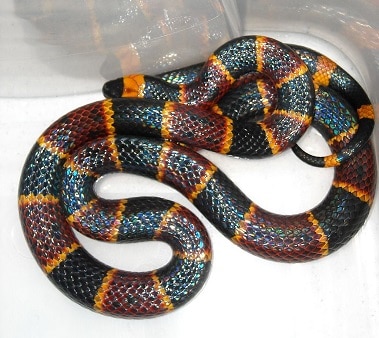
Location: southeast USA.
A species that all citizens of Florida, Georgia, the Carolinas are taught to fear, but the local snakes should be just as terrified of them. As of 1996, the eastern coral snake (Micrurus fulvius) had been observed preying on 21 genera of snakes, and the list has only grown since then.
Eastern coral snakes are mainly found on the leafy floors of woodlands, rarely climbing trees. They have a neurotoxic venom designed for paralysing smaller snakes extremely quickly, to prevent a retaliatory strike. Eastern coral snakes average at 80cm, with a maximum of 129.5cm, and they wisely stick to snakes of about 50cm. These include the scarlet snake, a secretive burrowing species, the rough green snake, a lover of grass, and small mud snakes, a dweller of swamps. They also feed on the tiny Brahminy’s blind snake and Florida crowned snake.
Eastern coral snakes are also known to prey on their Florida woodland neighbour, the scarlet kingsnake. This species preys on snakes itself, which could theoretically create a once in a lifetime scenario: a snake within a snake within a snake.
Eastern coral snakes are sometimes spotted rummaging through fallen leaves, searching for burrowing snakes. However, they’re not immune to hungry predators themselves. They’re sometimes preyed on by American bullfrogs, which grip them with an unbreakable hold, and drag them down into the water to swallow.
| 9 | Banded krait |
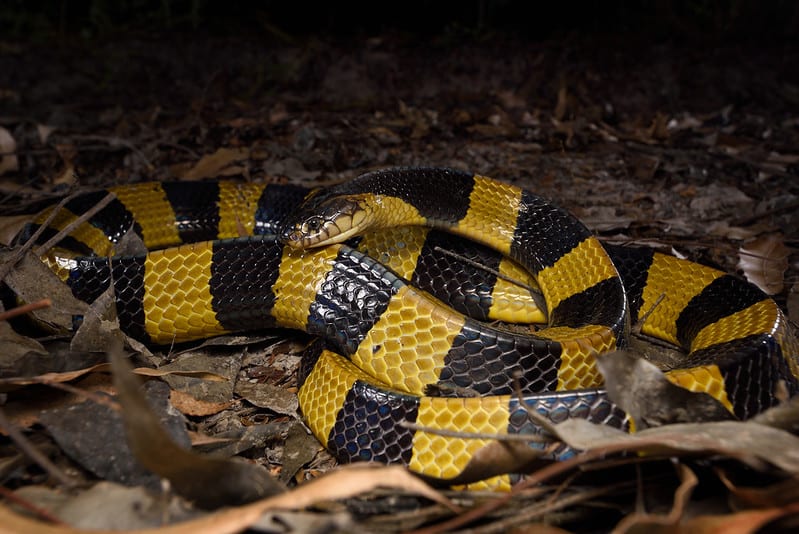
Location: south-east Asia.
A severely dangerous Thai species reaching a maximum of 212.5cm. A banded krait bite will kill 1-10% of humans if left untreated, so for a fellow snake weighing just 3-5 pounds, there’s no chance of survival.
The banded krait belongs to the 16-member Bungarus krait genus, all found in India and southeast Asia. Their relatives include the many-banded krait of Hong Kong, and the widespread Malaysian blue krait. The banded krait is recognisable by its bright yellow bands rather than white, but it shares the snake-addicted diet of its cousins. The banded krait has been observed eating…
-Checkered keelbacks, sunbeam snakes, common catsnakes.
-Rainbow watersnakes, Tonkin pitvipers, Russell’s vipers.
-Indochinese ratsnakes, oriental ratsnakes, buff-striped keelbacks.
Banded kraits even scavenge dead snakes similarly to crows, including a red-tailed pipe snake which had been mortally wounded by a rice harvesting machine. Another banded krait was run over in the process of swallowing a red-tailed bamboo pitviper, failing to realise the treacherous location it had chosen. They don’t have a free reign in southeast Asia, as banded kraits are sometimes hunted and swallowed by the king cobra.
When hunting snakes, banded kraits stick to two rules. They always swallow by the head, and they only swallow their prey after their venom has fully killed them.
| 10 | Painted coral snake |
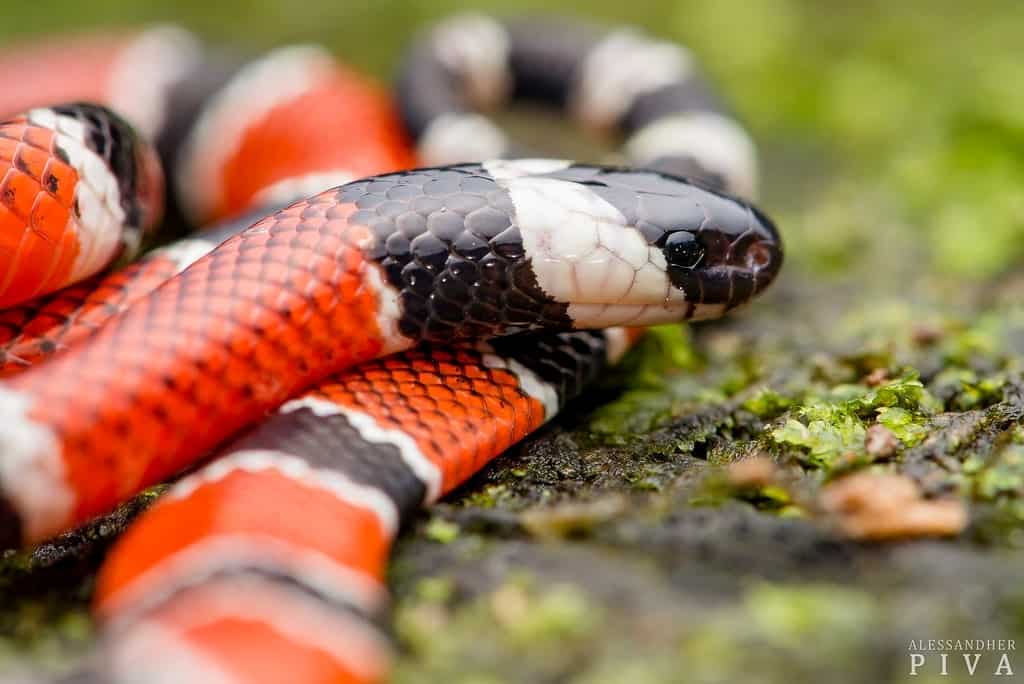
Location: northern Argentina, Paraguay, Brazil.
The bitiest of Brazil’s coral snakes, this species doesn’t necessarily have the most severe venom, but tops the statistics for annual bites, partly because it inhabits the populous southeast region. The painted coral snake (Micrurus corallinus) reaches a maximum of 98cm, with an average of 65-85cm, and derives most of its meals from fellow snakes. It particularly specialises in smaller burrowing snakes, such as the military ground snake and Neuwied’s false fer-de-lance, both with an average of 50cm. Other meals include burrowing blind snakes, which it drags out of the soil, including Brongersma’s worm snake and Ternetz’s blind snake.
This snake-eater varies its diet by location. One study found that snakes comprised 8.6% of their diet, but a study from southern Brazil’s Atlantic forests reached a verdict of 52%.
Coral snakes are nearly all venomous, and Micrurus corallinus has a treacherous neurotoxic venom, defeating its snake prey via respiratory paralysis. As the venom infiltrates a small blind snake’s body and causes a neuromuscular blockade, the smaller snake loses muscle control and the power to escape, or even bite back.
With snakes, painted coral snakes never relinquish their grip until their prey is fully dead, only then swallowing them. With lizards, they act differently, biting them and then letting go while they succumb.
